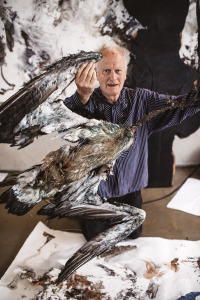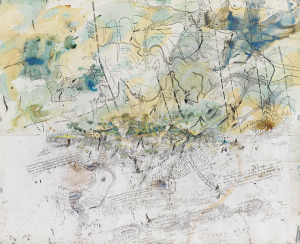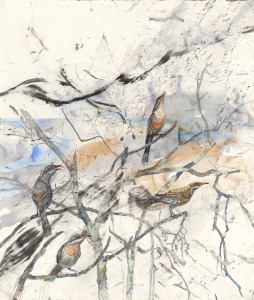Heartlands and Headwaters: John Wolseley at the NGV

Portrait of John Wolseley, supplied by NGV
John Wolseley is one of Australia’s most extraordinary landscape artists, and if you’re in Melbourne you can catch his landmark exhibition, Heartlands and Headwaters, at the National Gallery of Victoria until September 20, 2015.
I interviewed Wolseley regarding Heartlands and Headwaters, and the transcript follows.
First, a little background about the project from the NGV:
For four years, artist John Wolseley has roamed the coastal floodplains of the Northern Territory through to the glacial lakes of Tasmania, exploring and recording in exquisite detail the diverse wetlands of Australia. The works he has created will be revealed at NGV Australia, 11 April 2015.
This series of eighteen evocative works on paper, many of them monumental in scale (up to 10 metres in size), detail the geographical features and unique plants and animals of these wetlands in works characterised by minutely-observed drawing and rich watercolour washes.
Many works combine collage and unusual markings made through burying works or hoisting large sheets of paper across the charred remains of burnt tree trunks and branches. Through this ‘collaboration’ with the natural environment, Wolseley subverts traditional approaches to the depiction of landscape and seeking to give the natural world a more active presence in the work of art
‘Heartlands and Headwaters celebrates Australia’s unique and diverse natural environment,’ said Tony Ellwood, Director, NGV. ‘Wolseley’s work is not only of great beauty, but also demonstrates how depicting the landscape has become an important form of activism’.
The mangrove swamps of Roebuck Bay in Western Australia, the flood plains of the Gulf of Carpentaria in the Northern Territory, the Finke River in the Simpson Desert and the sphagnum swamps of Skullbone Plains in central Tasmania are just some of the sites detailed in these impressive works.
Commissioned by Sir Roderick Carnegie AC, these works celebrate the beauty of the Australian wilderness and encourage an understanding of the significance and environmental fragility of these remote and little-known sites.
Here, then, is my interview with Wolseley.
Sir Roderick Carnegie once commissioned work from Fred Williams. Did you meet Williams?

John Wolseley
History of the Whipstick Forest with ephemeral swamps and gold bearing reefs 2011 (detail)
watercolour, charcoal, pencil and on 2 sheets
(a–b) 233.5 x 286.6 cm (overall)
Collection of Sir Roderick Carnegie AC and Family
© John Wolseley
What’s rather lovely is that I saw quite a bit of him. I came here (to Australia from the UK) in 1976, and when I first met him he sort of pointed me in certain directions of which landscapes to look at and things like that. I was laughing to myself the other day that I was drawing some grass trees and I suddenly remembered that he said, ‘you have to go and look at grass trees’.
Did you know each other well?
We had some really good talks. One thing he said to me, which was really nice, was something like, ‘the way you draw the really tiny things of plants and insects and so forth, I think you’re on to something very special there’, he said.
Your interest in ornithology and natural history? Did that happen as a boy in England?
I think I became a passionate little boy naturalist when I was sort of six onwards, because I lived on a farm on the edge of Exmoor, so I could spend all day wandering around in the forests and rivers and things. I think it all started then. And I was sent away to boarding school. I had various pets. I had two different kinds of voles and three different kinds of field mice, snakes, lizards and salamanders and also giant tropical moths which I bred at school in London.
There’s a book I found when I was 13 called Giants Moths of the Jungle. You can buy the eggs. So I had bright green caterpillars with tassels and things like that. In the carpentry department I made a special cage.
This love of animals goes right back. Did your parents live on a farm in Exmoor?
It was the remains of a very old estate and there were two wonderful Shire horses used for ploughing and also doing things like getting the hay on wagons. It was ridiculously Medieval. Funnily enough my father was an artist and one of his friends was an artist called Alfred Munnings. So I used to see a bit of Alfred Munnings, and I even drew a horse when I went to art school and he gave me some tips. Apart from Stubbs, (Munnings) would be the most famous painter of horses, racehorses and hunting horses.
To carry on why I’m interested in the natural world, I ran away to Paris and studied etching and engraving with S.W. Hayter. He was a very inventive chap. He did the kind of etching which is called the viscosity technique. He printed for lots of artist like Miro and Roberto Matta, and when I was 20 I helped Miro print his etchings. He was absolutely the sweetest little chap, and he’d say things like, ‘oh, do you think this is any good?’ And one day he came into the studio and he’d picked up a rhizome from some kind of reed that he’d found in the Bois de Boulogne, I think, and he brought it in and he said, ‘this is where it all starts’, he said.
Getting back to your exhibition, Heartlands and Headwaters. This has occupied you for four years?
The main thrust is stuff I did over that four years. Where it’s a very unusual show is I have a method of working in the bush. I have about 20 different methodologies or systems which range from frottage to making scientific diagrams of natural phenomena.
The techniques are so interesting. There is a video of you inking up the carcass of a pelican and smacking it on to your paper.
I suppose they’re just one of many systems in which I find ways to collaborate with the actual physicality of the plant or tree or rock. They’re different ways of narrowing the gap between the artist and the actual artwork.
(On a moonlit night in the Gulf of Carpentaria, Wolseley dipped a sheet of paper in the sea while the coral were spawning.) I lifted them up slowly, and there they were, sitting there on the paper like a sort of aquatint. Really beautiful.

John Wolseley
After fire – spiny-cheeked honeyeaters at Lake Monibeong 2009–11 (detail)
watercolour, charcoal, pencil, gouache and brown chalk
(151.7 x 128.9 cm)
Collection of Sir Roderick Carnegie AC and Family
© John Wolseley
Did you ever think you would become a naturalist rather than an artist?
Um, no, I’ve always said that I’m a pretty wonky scientist.
The other technique you use is where you take the paper out of doors and allow the bush to draw itself with the charcoal after a bushfire. Or you might even bury the paper and retrieve it later.
The burying paper thing’s been going on for about 20 years. But the frottage, the actual moving the paper against trees, started when I was artist in residence at Sydney Grammar School. It was when those big fires had happened in the Royal National Park. That all really started then. I should think it was probably 14 years ago.
It happened accidentally when the drawing I was doing blew off the easel and landed on some kind of burnt hakea or banksia and I thought, ‘the drawing they’re making is better than the drawing I’m making’.
It takes a certain amount of letting go on the part of the artist?
Yes, I think that’s a good point. You could say that a lot of art is the artist composing mental constructs on the paper. Half way through that you might have Jackson Pollock. That I see as half way between imposing and allowing the natural world to reveal itself. And the thing about just throwing bits of paper in the wind and letting them bounce around for six months in the desert wind is the ultimate release of one’s own controlling instincts and allowing the bush to take over.
The paper sometimes couldn’t be found when you came back for it?
About 30 per cent of them get lost; I can’t find them. I was once lying on my back when I’d done all this throwing about, and I looked up and saw a wedge tailed eagle incredibly high up, and then a bit above it were three of my frotts, as I call them, sail around in a kind of whirly whirly. It was quite clear that my artworks were going up and up and up and would probably disappear.
What of the pieces of paper that you do retrieve?
They had, as it were, done their own research and registered the charcoal fingers of all the different trees in such a way that I can actually point to a group and say, ‘these ones were done by a slender leafed mallee and these ones it was probably up against a banksia’.
Elizabeth Fortescue, June 25, 2015
| Print article | This entry was posted by Elizabeth Fortescue on June 25, 2015 at 11:07 pm, and is filed under News. Follow any responses to this post through RSS 2.0. You can leave a response or trackback from your own site. |
